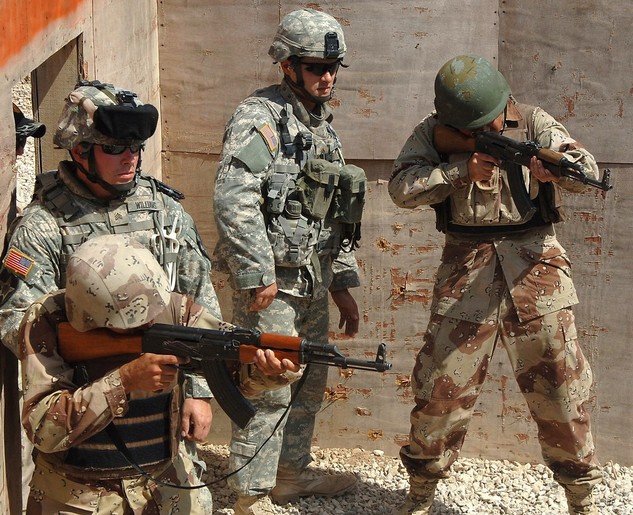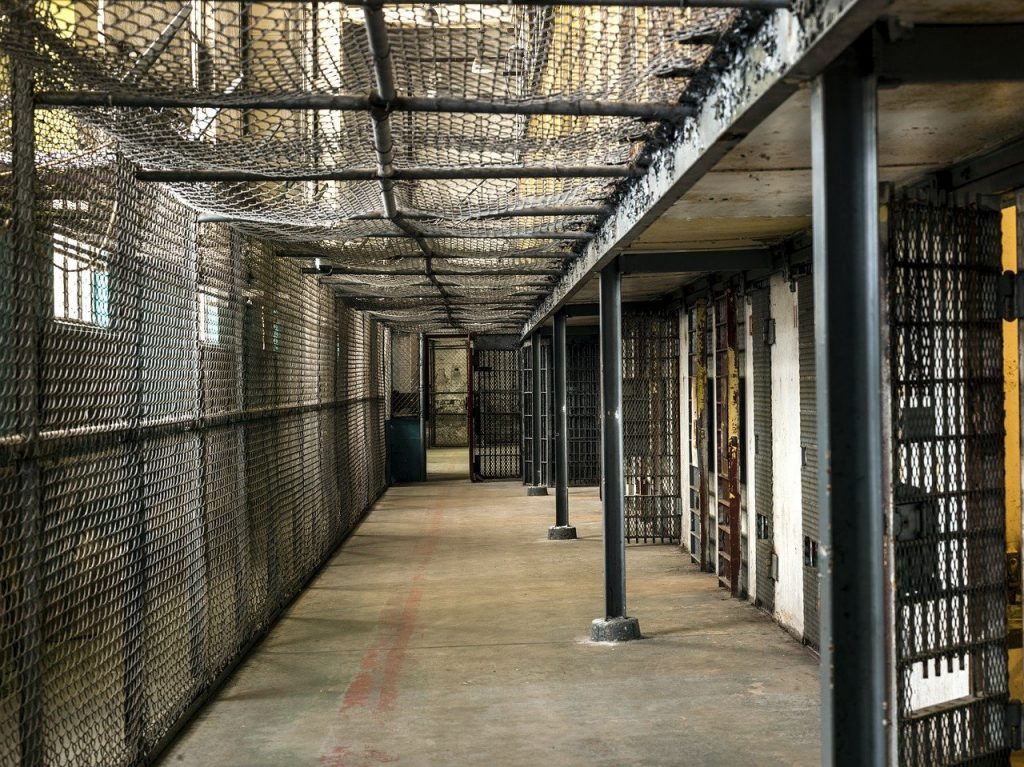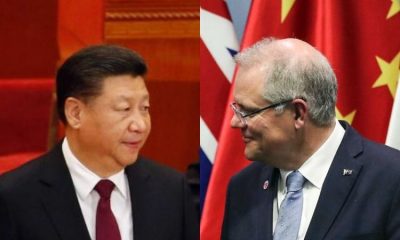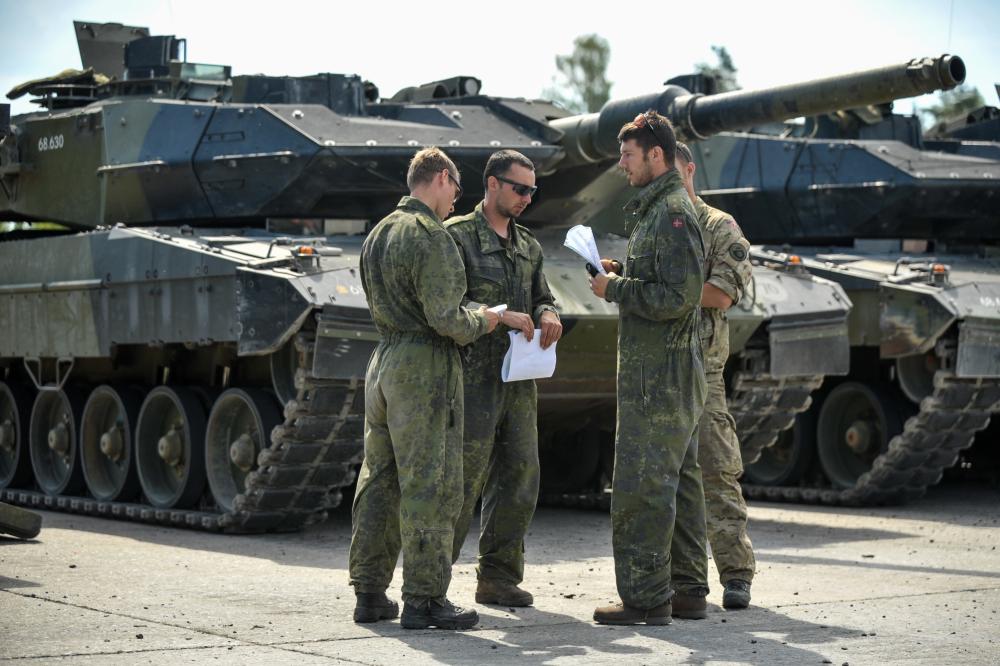
In half a century, record time by historical standards, the United States militarily dominated the world. In the decades which followed the birth of the new world order, America sought to secure this domination, using the same trick which had panned out for them during World War 2: converting their unrivaled economic power into military might. But the strategy seems to have backfired, due to lack of strategic insight, and the United States Army is now realizing that several armies dispose of better equipment than they do.
The United States came to par on fighter planes during world war two, when it managed to fight Messerschmitts and Zeros on a rather level field. Just after the war, prop fighters were quickly replaced with jets, and thus started the generations. Nowadays, poor countries have no air force, developing countries have third-generation fighters (such as Saab 37 Viggens, Migs 21 to 25 and Sukhois 15 to 17). 4th generation jets replaced them in the 1980s, with new characteristics ranging from long-range engagement (destroying an enemy beyond visual range with missiles), super-cruise (maintaining supersonic flight without afterburners), low-radar signature and computerized avionics. These jets, namely F-14 to 18, Typhoon, Rafale, equip the air forces of all developed countries, save one. The United States used their formidable military funding to leap into the 5th generation, where they stand alone, with the F-22 and the F-35. The gist was to cram all jets into one, able to perform all missions, from ground attack to air interception, and from reconnaissance to electronic warfare. After a bottomless pit of investment (unit cost soared during development and reached over twice its initial price of 75 million dollars per aircraft, totaling a 400-billion-dollar operation) and many years of production lag, the F-35, during a mock-fight against a 4th generation F-16 (30 years older), was unable to intercept the decoy, for lack of turning radius. Which is more: many retrofitted or upgraded 4th generation planes have similar performance, and have cost their owning countries a fraction of the bill. Now, one may say that money is no issue to the bottomless American wallet, but it is known to many that equipment too expensive to be maintained tends… not to be maintained. General Patton, for example, was lucky enough to have been born in wealth, which enabled him to buy the spare parts for his tanks, on his own funds. An eventually inevitable slump in the economy will paralyze any high-maintenance air force.
Americans made the same mistake regarding land vehicles: too much, too expensive, too rigid and without much point. The same US Army was able to defeat hardened enemies using nothing but equivalent equipment, tactics and fortitude in France, Germany, the Pacific, Vietnam, Korea – Iraq being left aside, as the army was ill-prepared, ill-equipped and already disbanding when the Americans invaded. The Future Combat Systems programs intended to replace every vehicle in the army with a newer generation, introducing unmanned vehicles in the battlefield for the first time. A closer look at the artillery section of this program is interesting. The current Paladin self-propelled howitzers (M109s, in all its different variants) is at par with all other equivalent cannons in the developed world, in the sense that it holds the same crucial characteristics. Among those: low deployment time, ability to switch types of shells rapidly, and the so-called “Mercy system” (MRSI – Multiple rounds, simultaneous impact) as well, of course, as standardized ammunition. But having rigged the vehicle with all sort of additional high-tech equipment made it unreliable, to the extent that several NATO partners which had purchased the Paladin quickly phased them out for alternative, more battle-proven and reliable alternatives. It isn’t so much that the Paladin isn’t properly designed (though it has its technical issues), it’s that it was designed to fight something which is nowhere to be found (a large conventional enemy) and not the current enemy. High-tech, but fragile and inflexible, and therefore ill-adapted to the needs of the army.
The Nexter Caesar artillery system makes a good comparison point. The truck-mounted 155-mm cannon was deployed in Afghanistan, where artillery fire must cover immense areas (in a rather conventional way), and in Mali where innovating use was made of it, in a way that intrigued generals around the world. The Caesar was used where it was expected the least, in combat facing armed insurgents in small mobile teams. It performed highly in offensive actions, thanks to its extreme deployment speed (high on-road and off-road velocity, and below three minutes to deploy the cannon) and provided high protection, both with armored cabins and with its scrambling speed which protects it from counter-battery fire. The now-combat-proven Caesar therefore proved a dogged threat to infantry-type insurgent formations, while being protected from them. At the same time, it remained immune to artillery fire, which insurgents did possess but were unable to use effectively, for lack of pinpointing French howitzers.
While proper and adequate funding is essential, pouring money onto the battlefield isn’t the solution to everything. Extravagantly sophisticated weapons systems have proven, prove and will prove unreliable on the battlefield, and they run a fair chance is missing the war. The United States is shipshape to fight the cold war which ended 20 years ago, but unable to prevail in Iraq and Afghanistan. Only rugged and flexible material will pass the test of fire to become battle-proven enough to bring countries to commit to it long-lastingly. While 5th generation fighter sales are either lagging or blocked by Congress, 4th generation sales are healthy and picking up. And while countries are, one by one, decommissioning the Paladins, the Caesar sales are on the rise, with Thailand, Indonesia, Saudi Arabia already in the club, and Vietnam soon to join in. In the last case, Dô Ba Ty, Vietnamese Army Chief of Staff, recently express strong interest for Caesar systems, in the context of rising tensions with neighboring countries and especially China. Something to watch out for, over the next while.
China
Nepal Hindu Rashtra: Time to Wrap Up Communism?

Nepal abolished the Constitutional Monarchy in May 2008 and declared itself as a Federal Democratic Republic. There was a new hope in Nepal as it was becoming world’s newest democracy even though it had dissolved the Hindu Rashtra. However, the democracy in Nepal immediately got into the tight grips of leftists and communists backed by China. It has been almost 12 years since monarchy was abolished in Nepal. Interestingly, the Himalayan country has already seen 11 Prime Ministers in this period. Thus, leaving the Nepalese people still yearning for good and stable governance.
Re-establish Hindu Rashtra
As the political instability is growing in Nepal, people are demonstrating concerns about the future of the country. In fact, Nepalese citizens are unhappy with frequent interference by China and India influencing its unstable communist regime. More voices are now growing in support of reinstating the Monarchy and declaring Nepal as world’s only Hindu Rashtra (which by default offers full religious freedom to other religious minorities as per Hindutva concept of Sarva Dharma Sama Bhava – all paths lead to one).
Former Deputy Prime Minister of Nepal, Kamal Thapa said that if political parties do not recognize the seriousness of reinstating the monarchy, then the country will head for a period of darkness. “Recently, we’ve had high-ranking officials from India and China come to Nepal to try and solve problems within the ruling party,” he said. “We cannot let others dictate what we want to do.”
Communist Party All Set to Suppress Protests, By Force
Kamal Thapa has firmly demanded an all party meet to discuss reinstating of monarchy. Throughout the month of December, 2020 Nepal has seen anti communism protests across the country in support of reinstating the monarchy and Hindu Rashtra. Most importantly, the demand has become a nationwide mass people’s movement. So much so that the communist regime had to send a directive to 77 districts in 7 provinces. The directive suggests suppressing the protests by force. Nevertheless, Rashtriya Prajatantra Party and other royalist groups have ignored this threat from the communist regime. Protester groups have pledged to strengthen the protest in the coming weeks.
Nepal: Demonstration held in capital Kathmandu, demanding restoration of monarchy in the country. pic.twitter.com/TFjmKu9U9Z
— ANI (@ANI) December 5, 2020
Role of China – Hope for Communism in Nepal
China’s ambassador to Nepal is known to have very close relationship with Nepalese Communist regime. In fact, She has been super effective in tilting Nepal’s posture towards its ideological partner, China. One of her greatest achievements in 2020 was artificially manufacturing a border conflict between Nepal and India. Consequently, souring relations between the two Hindu majority nations. In addition, she managed to silence Nepal’s communist government after China took one of Nepal’s border villages under its control. However, recent political turmoil in Nepal and a renewed demand for reinstating of Hindu Monarchy is showing that the situation is now out of Chinese hands
Role of India
Year 2020, was not a good year for India and Nepal relations. India was busy in controlling domestic Covid cases. On the other hand, China had launched an invasive campaign into Indian territory. In addition, India is always busy with Pakistan on its western borders. However, the surprise came to India when China was almost successful in creating a new border tension between India and Nepal.
Those who do not know about Indian government should note that the current ruling party in India finds itself ideologically opposite to communism. This further creates differences between the two countries.
Communist party in Nepal has blamed India for supporting the ongoing anti communism protests in Nepal. However, former advisor to Nepal’s PM has suggested there is no proof that India is fueling pro Monarchy, anti communism demand in Nepal.
Nevertheless, There are certain influencers in India who have, in their personal capacity, expressed support for reinstating the Hindu monarchy. Yogi Adityanath, who is the Chief Minister of an Indian state bordering Nepal, said in 2015 that Nepal should declare itself a Hindu Monarchy. Readers should note that in 2015 Yogi Adityanath was not the Chief Minister yet. However, today he is not only popular in south of Nepal, his popularity is growing in Nepal as well.
Will The World See the first Hindu Rashtra?
It is difficult to answer this question at this moment. However, Nepalese communist government could not resolve the political instability and in December 2020 Nepalese government dissolved the parliament. Nepal will see next elections in April – May 2021. Hopefully, the world will see Nepal’s 12th Prime Minister in 13 years or may be a Hindu King? Royalists and protester groups have expressed confidence in winning next elections. We have our eyes on Nepal for updates.
Opinion
America’s Justice System – The Need For Reform

A recent poll by the National Opinion Research Centre revealed that 95% of Americans favour vital criminal justice reforms. This is hardly surprising, given that several people of varying racial, partisan and ideological dispositions have called out the justice system over its many failures throughout the years. Most Americans received the Trump Administration’s First Step Act as a step in the right direction, as about 60% of people approved the criminal justice reform bill according to a 2018 poll. However, many people still believe the justice system’s approach to crime is ineffective and needs dire change, and these are some reasons why.
Prison population and funding concerns
Research conducted revealed America has about 2.3 million prisoners, making the US the country with the highest incarceration rate globally. Experts estimate that the country’s prison population has grown by a whopping 340% over the past three decades; new prisoner admissions into jails are higher than prisoner release numbers. The cost of maintaining the nation’s prisons at taxpayers’ expense has inspired a lot of backlash and calls for budget cuts. According to research, slashed correction spending was the preferred option by most states to balance their budgets and redirect spending to other areas.
Minimum mandatory sentences
Minimum mandatory sentences are statutes that force judges to give defendants convicted of a crime the minimum prison sentence. Mandatory sentences rob judges of the traditional way of considering the defendant’s character and the unique circumstances surrounding offences. Even when represented by criminal defense attorneys with many years’ experience, defendants often succumb to prosecutors’ pressure to plead guilty or face more severe charges with higher mandatory sentences. The guilty plea bargain consequently resolves about 95% of both federal and state court cases. Research also shows that about half of inmates in federal prisons are doing time for drug offences- causing overpopulation in the prison system.
Growing number of people killed by the police
An estimated 1000 civilians are killed by police officers annually in the US. The frequency of police brutality cases over the years requires immediate reform to the American justice system. Data suggests that the incidence of fatal police shootings is higher among African-Americans than any other ethnicity, inspiring movements like the ‘Black Lives Matter’ campaign to press on with protests for significant police etiquette reforms towards coloured minorities. The police force faces incessant accusations of racial profiling, indiscriminate use of power, and poor discretion, which has led a reported 58% of Americans to think policing needs major reforms through measures like better-trained officers, and wearing body cameras.
Evolving public opinion on crime
Research released by the Sentencing Project and The Justice Policy Institute reveals that more people in conservative states are embracing preventive, rehabilitative, and alternative sentencing options for non-violent offenders. Most Americans now view the prevention of crime as the most vital function of the justice system, as 77% of Americans think that focusing more on character education and after-school programs would be cost-effective by reducing the number of people going to jail. Almost two-thirds of Americans also believe in the need for lighter sentences with more useful, reformative programs in prisons that will benefit inmates upon release. Therefore, support for harsh penalties that harden criminals and make them a more significant menace when reintroduced into society has dwindled.
Opinion
The History Question: Is It Better to Remember or to Forget?

Years ago, a philosopher by the name of George Santayana said a phrase that fuels many debates to this day. His original saying is “those who cannot remember the past are condemned to repeat it”, although, many sources now present it as variations of “those who cannot learn from history are doomed to repeat it”. The latter definitely has more substance to it in the light of the ongoing debate about how much history we should be learning and how.
Is It Better to Remember or Forget About the Past?
On one hand, Santayana was right. Learning about the past is essential in order for people to progress. One also shouldn’t overlook the importance of remembrance and paying respects to the dead, both those who pushed the progress forward and those who have fallen victims to major tragedies that could and should have been averted.
The main argument in favor of learning about the past is that its knowledge is necessary for preventing the same thing happening in the future. Having it one can see the signs and stop the tragedy before it gains momentum.
That’s sound in theory, but the reality is always different. For example, today people are surely forgetting, and the much-critiqued education system is only partially at fault here. Even the greatest of tragedies weren’t spared this fate. It’s a proven fact that about two-thirds of millennials today don’t know about the Holocaust, and this number is surely greater for generations that follow them. In the school history course, the subject of one of the greatest disasters in history is barely touched, if touched at all. And outside of a history classroom, one can only see small, but terrifying, glimpses of it at the Holocaust Museum and other museums that rarely attract many visitors. And now we are witnessing a rise of antisemitic crime.
Are these two facts related? Does the lack of awareness about the horrors done in the name of Aryan supremacy contribute to the fact that right-winged extremists seem to be gaining popularity again?
It does, but by how much? That is the question that no one can truly answer.
And what about other genocides? The Holocaust had the highest death toll, but it was far from the only genocide in history. And quite a few of those happened after World War 2 and before the memory of the atrocities against the Jews began to fade. This means that while forgetting history is a factor, it’s not the deciding factor in its repeats.
But what is that thing responsible for the reenactment of past mistakes and tragedies?
Learning. This is the important thing that is most often overlooked when citing Santayana’s famous saying. It’s not enough to learn about the past and know the facts of things that happened. It’s important to learn from those facts and put in place protections that will prevent them from happening again. And this is something that humanity, as a whole, has yet to succeed in doing.
Dwelling in the Past Can Be Just As Bad
One also shouldn’t forget that there is such a thing as “too much history”. The Bosnian War and genocide that happened there in the 1990s is a vivid example of how the past can be exploited by political powers. Used as a part of propaganda, which fueled the war, history can become a weapon in the hands of those who want to use it for their own goals.
And this is what humans have been doing since the dawn of time. There is always someone who will use any means necessary to achieve whatever it is they wish. This results in wars and genocides, and hundreds of smaller but no less devastating tragedies.
Therefore, the problem isn’t whether people should be learning history but human nature itself. Perhaps, teaching this can help fix this fundamental flaw and truly stop the worst of the past from repeating.
-

 Business10 months ago
Business10 months agoHow To Future-Proof Your Business With The Right Tools
-

 Travel8 months ago
Travel8 months agoTravelling from San Antonio to Guadalajara
-

 Business11 months ago
Business11 months agoWhat are EDC products, and why should you always have them?
-

 Travel5 months ago
Travel5 months agoTravel wellness tips for a healthier and more enjoyable journey
-

 Europe4 months ago
Europe4 months agoRecent Books by Boaventura de Sousa Santos: Law, Colonialism, and the Future of Europe










